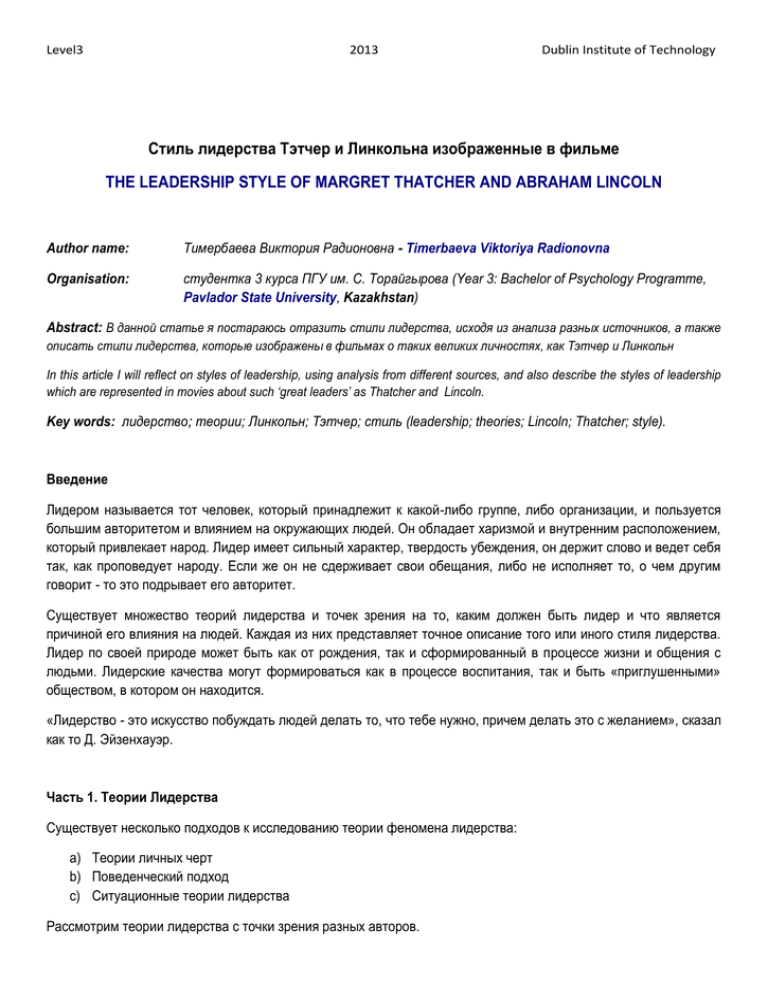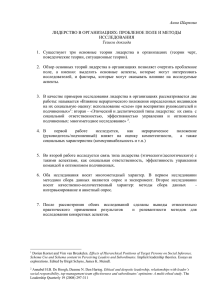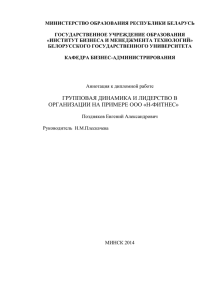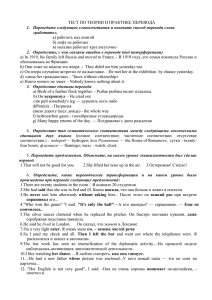Стиль лидерства Тэтчер и Линкольна изображенные в
реклама

Level3 2013 Dublin Institute of Technology Стиль лидерства Тэтчер и Линкольна изображенные в фильме THE LEADERSHIP STYLE OF MARGRET THATCHER AND ABRAHAM LINCOLN Author name: Тимербаева Виктория Радионовна - Timerbaeva Viktoriya Radionovna Organisation: студентка 3 курса ПГУ им. С. Торайгырова (Year 3: Bachelor of Psychology Programme, Pavlador State University, Kazakhstan) Abstract: В данной статье я постараюсь отразить стили лидерства, исходя из анализа разных источников, а также описать стили лидерства, которые изображены в фильмах о таких великих личностях, как Тэтчер и Линкольн In this article I will reflect on styles of leadership, using analysis from different sources, and also describe the styles of leadership which are represented in movies about such ‘great leaders’ as Thatcher and Lincoln. Key words: лидерство; теории; Линкольн; Тэтчер; стиль (leadership; theories; Lincoln; Thatcher; style). Введение Лидером называется тот человек, который принадлежит к какой-либо группе, либо организации, и пользуется большим авторитетом и влиянием на окружающих людей. Он обладает харизмой и внутренним расположением, который привлекает народ. Лидер имеет сильный характер, твердость убеждения, он держит слово и ведет себя так, как проповедует народу. Если же он не сдерживает свои обещания, либо не исполняет то, о чем другим говорит - то это подрывает его авторитет. Существует множество теорий лидерства и точек зрения на то, каким должен быть лидер и что является причиной его влияния на людей. Каждая из них представляет точное описание того или иного стиля лидерства. Лидер по своей природе может быть как от рождения, так и сформированный в процессе жизни и общения с людьми. Лидерские качества могут формироваться как в процессе воспитания, так и быть «приглушенными» обществом, в котором он находится. «Лидерство - это искусство побуждать людей делать то, что тебе нужно, причем делать это с желанием», сказал как то Д. Эйзенхауэр. Часть 1. Теории Лидерства Существует несколько подходов к исследованию теории феномена лидерства: a) Теории личных черт b) Поведенческий подход c) Ситуационные теории лидерства Рассмотрим теории лидерства с точки зрения разных авторов. Level3 2013 Dublin Institute of Technology Согласно Уоренну Беннису черты лидера составляют такие качества как: направляющее видение, страсть, целостность личности, доверие, любознательность, дерзновенность. С точки зрения Барт Нануса лидеру присущи такие свойства характера, как: прозорливость, искусство осуществления перемен, способность к построению организаций, высокая честность и цельность характера, инициативность, совершенное понимание взаимозависимости, способность к опережающему обучению. Очень известный специалист в области теории лидерства, Стивен Кови выделил 7 навыков поведения лидера: постоянное обучение, ориентированность на служение, излучение положительной энергии, вера в других людей, уравновешенный образ жизни, восприятие жизни как приключение, стремление к синергетике, занятия физическими, интеллектуальными, эмоциональными и духовными упражнениями для самообновления. Лидерство, как ситуационный феномен, рассматривал А. Бевелас и выделил следующие принципы лидерства: a) сходство между организационными структурами свидетельствует о наборе качеств лидера, который в данных условиях может выступать в его роли; b) уникальность любой отдельно взятой организационной структуры вынуждает учитывать ситуационные факторы, влияющие на поведение лидера; c) в случае изменения ситуации невозможно определить, какие качества лидера будут оптимальными. Наиболее популярная, наверное, на сегодняшний день, это ситуационная теория лидерства, которую предложили Р. Хаус и Г. Митчел. Эта теория рассматривается, как способность человека распределить вознаграждения между подчиненными в зависимости от результатов их деятельности. Согласно этой теории, лидер должен демонстрировать следующее поведение: a) он всегда должен показывать, каким образом связаны результаты работы подчиненных с их должностным ростом; b) за выдающие особенности деятельности подчиненных они должны получать материальное вознаграждение; c) необходимо ставить цели перед подчиненными и указывать на связь достижения этих целей и четких последствий; d) руководитель всегда должен оказывать подчиненному помощь в достижении его собственных целей; e) помогать советами и передавать свой личный опыт подчиненным. Часть 2. Анализ стилей лидерства Тэтчер и Линкольна В отношении Маргарет Тэтчер здесь можно отметить, что большинство ее биографов отмечают особую роль отца девочки, общественная деятельность которого, несомненно, повлияла на дальнейший выбор ее профессии (несмотря на то, что изначально она получила другое образование и была активна не только в сфере политики) и политическую ориентацию на консерватизм. В семье Маргарет были привиты такие качества, как трудолюбие, упорство и большая степень самоотречения в работе, которые потом выделялись как основные характеристики, сказавшиеся в ходе ее деятельности. Стиль управления Маргарет Тэтчер был уникальным. Он отражал новый подход к решению важнейших государственных проблем. Она привнесла в политическую жизнь страны принципиально новую философию управления, получившую название «тэтчеризм». Стержнем, делающим лидера лидером, является понимание сути сложившейся управленческой ситуации, того, как ее следует преобразовать, и пути осуществления такого преобразования. Именно это в современной науке об управлении называется видением. Маргарет Тэтчер им обладала в полной мере. Ее стратегией была стратегия «здравого смысла», позволявшая ставить верные цели и добиваться успеха в их достижении. Level3 2013 Dublin Institute of Technology Согласно Г. Лассуэллу, Линкольн относится к лидеру-идеологу, который манипулирует идеями, концепциями общественного переустройства. Линкольн придерживался строгих моральных принципов нравственности, имел чувство юмора, но был склонен и к сильной меланхолии. По сей день Авраам Линкольн считается одним из самых интеллектуальных президентов Соединённых Штатов. Линкольн и Тэтчер обладали навыками лидерства. Оба заслужили авторитет и призвание, достигли многого в своей жизни и сделали ни мало для своей страны. Тэтчер является «великим человеком», хотя она не рождена была сразу с лидерскими качествами в характере, все пришло спустя жизненный опыт. Она обладала могущественной силой власти, наделенная характеристиками мужественности, жесткости, целенаправленности и т.д. Линкольн же обладал даром вести за собой народ, добиваться целей путем нравственности и мудрости. Ему присуща бихевиористская теория лидерства. Хотя каждая из теорий тесно пересекается между собой и имеет место быть у каждого из лидеров, т.к. люди в процессе жизни проявляют как свои собственные черты характера, так и привитые обществом и обстоятельствами. Заключение В заключении хотела бы подвести итог классификаций теорий лидерства. Несмотря на их большое разнообразие, большинство можно отнести к одной из восьми предложенных теорий: a) теории «великого человека» («лидерами рождаются, а не становятся»; они становятся героями и обожествляются, т.е. становятся уже легендами прижизненно), b) теории «характерных черт» (лидеры наследуют определенные черты, придающие им лидерские навыки), c) теории «обстоятельств» (успех зависит от целого ряда факторов, включая стиль руководителя, особенностей последователей, а также различные аспекты ситуаций), d) ситуационные теории (привлекательная идея, что различные обстоятельства требуют различных форм лидерства), e) бихевиористские теории («лидерами не рождаются, а становятся»; уделяется внимание именно действиям лидера, а не характерным особенностям его характера), f) теории силы и влияния (все дороги ведут к лидеру; концентрируют внимание на сетях власти и влияния, которые создает лидер в процессе своей деятельности), g) трансакционные теории «теории управления» (отношения лидера и его последователей), h) трансформационные теории (акцент делается на действительной приверженности идеям лидера; лидер трансформационного типа является активным и творческим человеком, умеющим думать широко и образно). Ссылки 1. Ильин М. В., Ковалев Б. И., Личность в политике: «кто играет короля?», — М. : 1991 г. — 130с. 2. Политология, под ред. Полуниной Г. В., — М. : «Акалис», 1996 г. — 75с. 3. Сэндберг К. Линкольн / Карл Сэндберг; сокр. пер. с англ. Б. Грибанова и Л. Шеффера. — М. : Москва, Молодая гвардия, 1961. — 700с. 4. Маргарет Тэтчер. Искусство управления государством. Стратегия для меняющегося мира. — М.: Альпина Паблишер, 2003. — 190с. 5. http://www.bglitvak.ru/?page_id=1157 Level3 2013 Dublin Institute of Technology Introduction As a definition, the person who heads up any group or organisation is called the leader: he/she has authority and influence on the surrounding people. The successful leader usually possesses charisma and internal qualities such as intelligence which attract followers. The successful leader usually has a strong character and firmness of belief. He/she keeps their word and behaves as gurus to the followers. If he/she doesn't keep promises made, or doesn't execute them, then this undermines his/her authority. Psychology offers sets of theories of leadership and points of view about the leader, especially about the core of his/her influence over other people. Each theory has a description of this or that style of leadership. The leader by nature can be a leader from birth, or can be created in the course of life in communication with people. Leadership skills can also be formed during the course of education and formation, and can be either "muffled" or nurtured by the society in which they operate. "Leadership is an art to induce people to do what is necessary for you, and to do it with desire", D. Eisenhower. Part 1: Leadership theories There are considerable research publications about leadership as a phenomenon, such as those about: a) Theories of personal traits and values b) Behavioural approaches c) Situational theories of leadership. Let's consider leadership theories from the point of view of different authors. According to Uorenn Bennis, the leader has qualities such as: directional vision; passion; integrity of personality; trust; inquisitiveness; boldness. From the point of view of Bart Nanusa, the following characteristics are inherent in the leader: insight; art of implementation of changes; ability to create the organization; high honesty and integrity of character; initiative; perfect understanding of interdependence; ability to benefit from advancing training. A well-known expert in the field of leadership theory, Stephen Kovi, marked out seven skills or behaviours of the leader: continuous training; focus on service; radiation of positive energy; belief in other people; the counterbalanced way of life; perception of life as an adventure; aspiration to synergetic occupations by physical, intellectual, emotional and spiritual updating. Leadership as a situational phenomenon, according to A. Bevelas shows the following principles: a) similarity between organisational structures testifying to a set of qualities of the leader who in these conditions can act in his/her role; b) the uniqueness of any separately considered organisational structure compels us to consider the situational factors influencing the behavior of the leader; c) in cases of change of a situation it is impossible to define what qualities of the leader will be optimum. The most popular today is the situational theory of leadership offered by R. House and G. Mitchel. This theory considers the ability of the person to distribute rewards among subordinates depending on the results of their activity. According to this theory, the leader has to show the following behavior: Level3 2013 Dublin Institute of Technology a) he/she always has to show how results of the work of subordinates are connected with their official purpose; b) they have to dispense material rewards to subordinates for displaying desired features; c) it is necessary to set the purposes before subordinates and to point to communication of achievement of these purposes and accurate consequences; d) the leader always has to help the subordinate in achievement of the leader’s own purposes; e) he/she passes on his/her personal experience to the subordinates. Part 2: Analysis of styles of leadership of Thatcher and Lincoln Concerning Margaret Thatcher, here it is possible to note that the majority of her biographers identify the special role of her father in her childhood and his interest in public work, undoubtedly, affecting the further choice of her profession, in spite of the fact that initially she got other education and was active not only in the policy sphere. But she had a political orientation to conservatism. In Thatcher’s family such qualities as diligence, persistence, and a big degree of selflearning from work which was allocated, are the main characteristics which have influenced her during her later life activities. The management style of Margaret Thatcher was unique. It reflected new approaches to the solution of major state problems. It introduced essentially a new philosophy of management which has received the name "Thatcherism" in the political life of the country. The core feature of this leadership style is the understanding of an essence of any developing administrative situation, what is necessary to transform it, and ways of implementation of such transformation. In modern science about management this can be called ‘vision’. Margaret Thatcher possessed it fully from her own perspective, though it was not necessarily shared by all her colleagues. Her "common sense" strategy, allowed her to set the ‘right’ purposes and to achieve success, regardless of consequences. She is regarded as the Prime Minister who divided a nation. According to G. Lassuell, Lincoln represents the leader/ideologist who manipulates ideas and concepts towards public reform and reorganisation. Lincoln adhered to strict moral principles and ethical responsibility. He also had a sense of humour but was inclined to strong melancholy. To this day Abraham Lincoln is considered one of the most intellectual presidents of the United States and his legacy endures with respect and high regard. Lincoln and Thatcher possessed skills of leadership. Both commanded authority and were committed to their ‘calling’. They both achieved much in public life and made significant impacts on their countries. Thatcher was a "the great person" according to theories of leadership though she wasn't born to greatness herself, or universally liked. But she developed leadership skills in character, and everything came later through life experiences and her ability to learn from them. She possessed a powerful personality, with characteristics of courage, rigidity and focus. Lincoln had the gift to lead people and to achieve his objectives by moral determination and reflective wisdom. The behaviorist theory of leadership is inherent in him. Though each of the theories of leadership are closely integrated with each other, it is really only after a leader’s full life that their traits of character can be fully considered and their impact on history and society fully understood. Conclusion In conclusion, I would like to sum up some common classifications of theories of leadership. Despite their big variety of theories, the majority are possible to identify within one of eight categories below: a) theories of "the great person" ("leaders are born, instead of being made"; they become heroes and are idolized and become becomes a legend, Level3 2013 Dublin Institute of Technology b) theories of "characteristic features" (leaders inherit certain features which give them leadership skills), c) theories of "circumstances" (success depends on a number of factors, including style of thinking, features of their followers, and also various aspects of situations), d) situational theories (attractive ideas that are appropriate in various circumstances demanding various forms of leadership), e) behaviourist theories ("leaders aren't born, they become"; the attention should be on the actions of the leader instead of on the characteristics of his character) f) force and influence theories (all roads converge in the leader; he/she concentrates attention on networks of the powerful and influential which are created by, and used by, the leader in the course of his/her activity), g) transactional theories of "management theory" (relations of the leader and his followers), h) transformational theories (the emphasis is placed on the valid commitment to ideas of the leader; the transformational leader type is the active and creative person with an ability to think widely and figuratively). References and Links 1. 2. 3. 4. 5. Ilyin M. V., Kovalev B. I., M. (1991). The personality in policy: "who plays the king?" Polunina G. V. M. (1996). Political science. Sendberg K. and Sendberg. M. (1961). Lincoln, Moscow. Thatcher. M. (2003). Management skill state. Strategy for the changing world. http://www.bglitvak.ru/?page_id=1157


